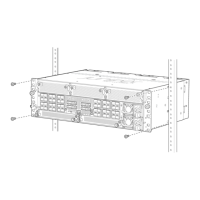Connect an ACX7348 Router to a GNSS Antenna
IN THIS SECTION
Gain and Noise Figure (NF) Calculaon | 90
Antenna Cable Specicaons | 90
Cabling Guidelines | 93
Global Navigaon Satellite System (GNSS) capability is essenal for the Grand Master (GM) clock
funconality. The ACX7348 router supports an internal receiver. A GNSS receiver receives signals from
a navigaon satellite constellaon. The GNSS receiver gains precise phase and me informaon by
processing these signals and delivers the informaon across the network.
You must install a GNSS antenna to ensure opmal signal recepon. Juniper supports the Furuno
AU-217 antenna. For informaon about installing the AU-217 antenna, see GNSS Antenna AU-217
Installaon Procedure.
Before you connect an ACX7348 router to the external GNSS antenna:
• Understand the antenna cable specicaons. See Antenna Cable Specicaons.
• Follow the instrucons in Cabling Guidelines.
To connect an ACX7348 router to a GNSS antenna:
1. Connect one end of the LMR400 cable to the GNSS connector port (labeled GNSS) on the ACX7348
router.
2. Connect the other end of the LMR400 cable to the GNSS antenna. See Figure 46 on page 91.
Gain and Noise Figure (NF) Calculaon
To calculate the total gain and NF, see GNSS Antenna Installaon Appendix on the Furuno data
download page.
Antenna Cable Specicaons
The following topology (Figure 46 on page 91) depicts the antenna cable connecons with connector
types. Use this topology as an example to install the antenna cables.
90

